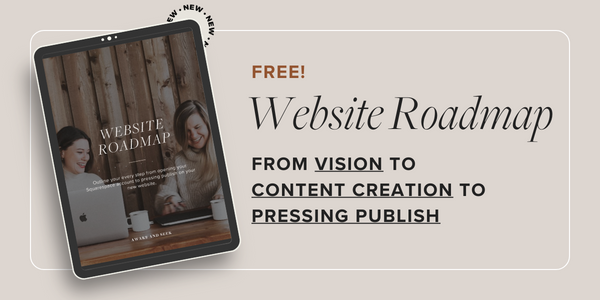5 Questions to Nail Your Website Strategy
I used to be pretty open-handed with several brand components, especially for women-run brands that needed to launch ASAP. But it's not 2021 anymore, and just any-old-thing isn't going to cut it for your people anymore. A lot has changed in the digital space, and one of those things is that you absolutely, for sure, need to have a website.
It doesn't need to be a huge, 6-page website, but not having a website in 2024 is like not being in the book in 1989. We're Googling all the things, and if you want your ideal audience to connect with what you offer, from coaching to photography to architecture to writing, you need to have a carefully curated, digital place for them to land.
If you feel the shame of "I know, I know," creeping up, kick that monster in the teeth right now, mmkay? There are a lot of steps between knowing something should be done and having it accomplished, let alone accomplished with confidence. I've worked with so many nonprofit, ministry, and small business leaders like you in the last 3+ years, and Mount Website seems to be the learning curve that holds back so many—too many—powerful passions. You're in great company.
One of the key phrases I hear from folks who feel trapped by their unlaunched website is:
"But what do I even put on my website?"
And that's fair. Especially if you came of age on the internet when 2009 blogs were all the rage, or Vines, or resumes, or internet shopping, it can be hard to imagine what you, just you, are supposed to put on your website. Should it be a list of your accomplishments? Stock photos? A whole separate page for testimonials? Do I need to have a tagline ready to go?
Here's where I want us to start: Your Website Strategy.
A "strategy" is the process we use to accomplish a goal. Your website strategy is the path we take your visitors through to accomplish your primary (and secondary) website goals. There's no one-size-fits-all here, and before we get into layout hierarchy, design, and messaging, we need to consider the framework of our entire site.
Here are 5 questions that will lead you to your website strategy:
What are you selling on your website?
You'd be shocked how often a client will wait 37 minutes into a 60-minute website strategy call to mention their coaching services, or speaking engagements, or upcoming conference. The core of your business is the core of your website. What do you sell? This isn't a trick question like "a healthy lifestyle," I'm talking about the products or services that you sell.
If you sell something, there's a super high chance that your primary website goal is to make more sales or get more bookings. Remember that strategy stems from goals, so it matters that we nail this down at the top.
How will people purchase what you're selling?
Will they buy your products right from your Shopify store? Will they book your services right away, or do they need to apply? What software do you want to use for those actions? Will they book and purchase through a 3rd party app like Square or Kajabi?
The purchase decision and purchase process are the end of the funnel we're creating on your website, and so we're working backward to create your strategy. If "purchase" is the last thing they do...how do they do it? This will also help you determine which website platform to choose.
If you're not selling anything, not to worry! The next 3 questions totally apply to you 🙂
What's the primary action you want people to take on your website?
Create a clear call to action (CTA) for your website visitors. We want to make it clear to your viewers what you want them to do next and to remove as much friction as possible as they get there. This is likely related to your sales, like "buy an article of clothing," "apply for coaching," "contact me for a design quote" or "purchase the course".
However, there's also a case to be made for having your primary action be a key driver towards another marketing tactic, like a driver to your email list. Typically getting on an email list is a secondary action, which we'll discuss in a moment, but there's definitely a strategy to driving all of your website viewers towards taking a quiz or grabbing a freebie. It's a lower-stakes offer and will likely yield big results for that marketing channel, but will only be effective if you're clear about your primary action across the website and you have a killer follow-up plan for the rest of the funnel once they join that marketing funnel. It all depends on your overall business strategy.
What are some secondary actions you want people to take on your website?
In Building a Story Brand, Donald Miller uses a great analogy to define the difference and importance of primary and secondary actions:
If the primary action is a marriage proposal, then a secondary action is a dinner date.
Ultimately, you know where you want the relationship to go, but depending on the status of the relationship with the purpose, a marriage proposal could be way too strong. The stakes are too high, the person isn't ready.
But a date? They could do a date. They could:
Read a blog post
Listen to a podcast episode
Sign up for your email list.
The rest of your website content should be in service to your primary action and your website goals, even the secondary actions or secondary content. What information do they need about me or my organization to make an informed purchase decision? What blog posts or resources do they need to feel prepared to invest in a few months? What do they need to know about my values or the quality of my clothing to feel loyal to this brand?
Consider the secondary content and actions you want to see on your site, and make sure you can draw a clear line from that content and secondary action to the funnel that will ultimately get you the primary action you're looking for.
What pages will your website have?
Based on all of the above information, what pages should your website have?
Knowing our goals and desired actions, we want your website to have all the information your viewers need to take those actions, and really nothing more. So how much content that is really depends on your audience, your goals, and your entire business plan and marketing strategy as a whole.
If you're just starting, you have never have never had a website and you're selling just one or two services, starting with a one-page website is an excellent idea.
For most small organizations, a 6-page website is sufficient to capture all of the relevant information, but of course, if your website is primarily an information-based platform or you sell many items of clothing, your site will be larger. You're a smart person and can figure out what your people need!
Some ideas for website pages are:
Home page of course, about page, services, a sales page for a course, blog, podcast, free resources or favorite things, contact, speaking, a page highlighting your book, events, portfolio, galleries, and shop, just to get us started.
So those are 5 questions to help you outline your website strategy as you get writing, designing, and building! To recap, they are:
What are you selling?
How will they buy it?
What is the primary website action?
What are your secondary website actions?
And what pages will your website have?
These questions were taken from our Website Roadmap workbook, which is an interactive PDF to help you plan and execute your website launch with a super straightforward checklist of steps from website strategy (which we just did) to domain purchase to pressing publish. It also includes a content checklist to make sure you've got all the necessary elements on each page. It's free, it's editable, it's helped leaders like you strategize and launch their sites in mere moments.
Grab it at awakeandseek.com/roadmap.
YOU MIGHT LIKE THESE BLOG POSTS:













